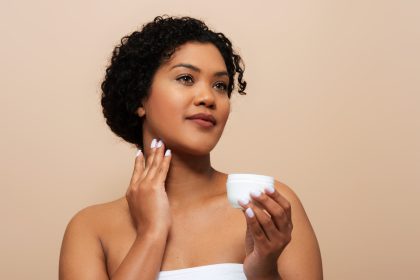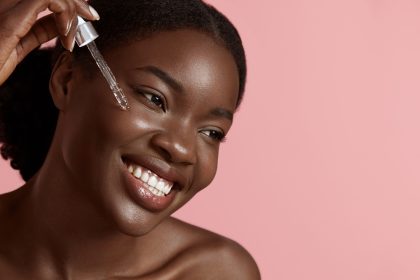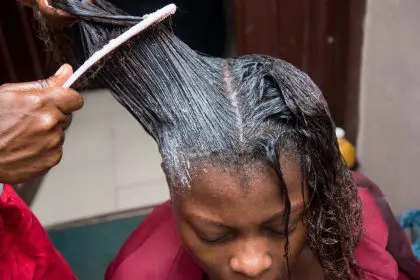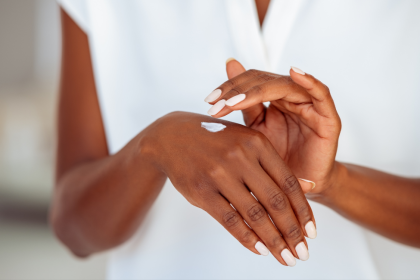As skin ages, the gradual loss of elasticity and firmness occurs through both natural processes and environmental factors. This inevitable change leads many to search for effective solutions beyond marketing claims and temporary fixes. Understanding both why skin loses firmness and which interventions genuinely work enables you to take evidence-based steps toward maintaining and restoring skin elasticity.
The science behind skin firmness
Your skin’s structure determines its firmness and elasticity through several key components working together beneath the surface. Understanding these elements helps explain why certain treatments prove effective.
Collagen provides the structural framework that gives skin its firmness. This protein makes up approximately 75% of skin’s dry weight and forms the supportive mesh that maintains skin integrity. Starting around age 20, collagen production decreases approximately 1% yearly, with dramatic acceleration during menopause for women.
Elastin fibers, as their name suggests, give skin its ability to snap back after stretching. These specialized proteins allow skin to return to its original position after facial expressions or movement. Unlike collagen, damaged elastin rarely regenerates effectively, making prevention of damage particularly important.
The extracellular matrix surrounds these proteins, providing hydration and nutrient delivery. This gel-like substance contains hyaluronic acid, which holds up to 1,000 times its weight in water, creating the plump appearance associated with youthful skin.
Several factors accelerate the breakdown of these crucial components. UV radiation generates free radicals that damage collagen and elastin while inhibiting new collagen formation. Advanced glycation end products (AGEs) form when sugar molecules attach to proteins, creating cellular damage and inflammation. Chronic stress increases cortisol levels, which break down collagen and impair new production. Environmental pollutants generate free radicals that accelerate skin aging through oxidative damage.
Understanding these mechanisms reveals why effective firmness-restoring methods work – they either protect existing collagen and elastin, stimulate new production, or temporarily mimic the effects of these structural proteins.
Topical ingredients with proven efficacy
Among countless skincare products claiming to restore firmness, scientific research supports several specific ingredients that deliver measurable results through distinct mechanisms.
Retinoids stand as the gold standard for skin firming, with decades of research confirming their efficacy. These vitamin A derivatives increase cell turnover, stimulate collagen production, and reorganize existing collagen for improved structural support. Prescription-strength retinoids like tretinoin show the most dramatic results, but over-the-counter retinol products at sufficient concentrations (at least 0.25-1%) also demonstrate significant benefits with consistent use.
Vitamin C serves dual functions in fighting skin laxity. This powerful antioxidant neutralizes free radicals that would otherwise damage collagen while simultaneously serving as a required cofactor for collagen synthesis. The most effective form, L-ascorbic acid, should be present at 10-20% concentration in an acidic formula (pH 3.5 or lower) for optimal penetration and stability.
Peptides work as cellular messengers that signal your skin to produce more collagen. Different peptide types serve distinct functions – signal peptides like palmitoyl pentapeptide-4 stimulate collagen production, carrier peptides deliver trace minerals necessary for healing, and enzyme inhibitor peptides block collagen breakdown. Products containing multiple peptide types often provide complementary benefits.
Niacinamide (vitamin B3) supports skin firmness through multiple mechanisms, including improving barrier function, reducing inflammation, decreasing hyperpigmentation, and protecting against oxidative stress. Research shows 5% niacinamide significantly improves elasticity and reduces fine lines when used consistently for 12 weeks.
Growth factors, naturally occurring proteins that regulate cellular growth and proliferation, show promise in advanced formulations. These specialized molecules stimulate fibroblasts to produce collagen and elastin while organizing their structure for optimal function. Most effective products contain multiple growth factors addressing different aspects of skin regeneration.
For maximum benefit, layer these ingredients strategically. Apply vitamin C in the morning for daytime antioxidant protection, followed by moisturizer and sunscreen. Reserve retinoids for evening application, followed by peptides and moisturizer. Niacinamide works well in either routine due to its complementary effects with other ingredients.
Professional treatments with significant results
When topical products alone prove insufficient, various professional treatments can significantly restore firmness through more intensive mechanisms targeting deeper skin layers.
Microneedling creates thousands of microscopic punctures using fine needles, triggering the skin’s wound healing response. This controlled injury stimulates collagen and elastin production that continues for months following treatment. Studies show a series of 3-6 treatments spaced 4-6 weeks apart can improve skin firmness by 40-50%, with results lasting 6-12 months before maintenance treatments become necessary.
Radiofrequency treatments deliver energy into the dermis through specialized devices, heating tissue to temperatures that stimulate collagen contraction and new production without damaging the outer skin layers. Modern devices combine this energy with microneedling for enhanced penetration. Most patients require 3-4 sessions spaced one month apart, with results developing gradually over 6 months as new collagen forms and remodels.
Laser resurfacing falls into two categories with different approaches to skin firming. Ablative lasers (CO2, Erbium) remove outer skin layers entirely, creating significant collagen stimulation and dramatic improvements with substantial downtime. Non-ablative lasers penetrate to deeper layers while leaving the surface intact, requiring multiple treatments but minimizing recovery time. Both approaches effectively stimulate new collagen formation through controlled thermal injury.
Ultrasound therapy, most commonly Ultherapy, delivers focused ultrasound energy to precise depths within skin and underlying tissue. This energy creates small thermal coagulation points that trigger healing responses and collagen regeneration. The unique advantage of this approach lies in its ability to target the deeper structural support layers that other treatments cannot reach, with results continuing to improve for 3-6 months following a single treatment.
Thread lifts provide more immediate results by mechanically lifting skin using special absorbable sutures with small cones or barbs. These threads physically reposition sagging tissue while stimulating collagen formation around the implanted material. Though not permanent, results typically last 1-3 years as the threads gradually absorb while collagen continues forming around them.
For optimal results, many dermatologists recommend combining these approaches strategically. For example, radiofrequency microneedling might address overall skin quality while ultrasound therapy targets deeper structural support, creating comprehensive improvement across all tissue layers.
Nutritional approaches to firmer skin
The foundation of skin firmness begins internally, with specific nutrients playing crucial roles in maintaining and restoring structural components through various biochemical pathways.
Protein intake directly impacts collagen production, as amino acids serve as the building blocks for this structural protein. Ensure adequate daily protein (0.8-1g per kg of body weight minimum), with particular attention to glycine, proline, and hydroxyproline – amino acids specifically concentrated in collagen. Bone broth, chicken, fish, egg whites, and dairy provide these specialized amino acids in bioavailable forms.
Vitamin C’s importance extends beyond topical application, as internal levels directly impact collagen synthesis. The body cannot produce this essential vitamin, making daily consumption necessary. Citrus fruits, bell peppers, broccoli, strawberries, and kiwi provide abundant vitamin C along with other antioxidants that protect existing collagen.
Omega-3 fatty acids contribute to skin firmness by managing inflammation, supporting cell membrane health, and maintaining skin barrier function. Cold-water fatty fish like salmon, mackerel, and sardines provide the most bioavailable forms (EPA and DHA), while plant sources like flaxseed, chia seeds, and walnuts contain ALA, which converts less efficiently in the body.
Antioxidant-rich foods counteract the free radical damage that contributes to collagen and elastin breakdown. Berries, dark leafy greens, nuts, and green tea provide particularly effective antioxidant profiles through compounds like anthocyanins, catechins, and various polyphenols that neutralize the oxidative stress accelerating skin aging.
Avoid dietary factors that actively damage collagen and elastin. Excessive sugar consumption promotes glycation, where sugar molecules attach to proteins and create AGEs that damage skin structure. Processed foods often contain both sugar and inflammatory compounds that impair collagen production while accelerating breakdown. Excessive alcohol dehydrates skin and depletes antioxidant reserves, leaving collagen vulnerable to damage.
While oral collagen supplements have gained popularity, research shows mixed results regarding their efficacy for skin firmness. Hydrolyzed collagen peptides may stimulate fibroblasts to produce more collagen and hyaluronic acid, though the specific mechanisms remain unclear. If trying this approach, hydrolyzed collagen types I and III show the most promising research for skin applications.
Lifestyle factors that preserve and restore firmness
Beyond specific treatments and nutrients, several lifestyle practices significantly impact skin firmness by addressing fundamental biological processes affecting skin structure.
Sun protection represents the single most effective preventive measure against skin laxity. Daily application of broad-spectrum SPF 30+ sunscreen, even on cloudy days, prevents UV-induced collagen and elastin degradation. Physical protection through UPF clothing, wide-brimmed hats, and sunglasses provides additional defense, particularly during peak sun hours (10 AM – 4 PM).
Adequate sleep directly impacts skin firmness through several mechanisms. During deep sleep, growth hormone levels increase, stimulating collagen production and cellular repair. Consistent sleep deprivation raises cortisol levels, which breaks down collagen while impairing new production. Aim for 7-9 hours of quality sleep, as studies show significant differences in skin aging between good and poor sleepers.
Regular exercise improves skin firmness through multiple pathways. Increased circulation delivers more nutrients and oxygen to skin cells while removing waste products more efficiently. Exercise also regulates hormones that affect collagen production, including reducing excess cortisol and potentially increasing growth factors that support skin structure. Studies show moderate exercise (30 minutes daily) improves skin composition even in previously sedentary individuals.
Stress management protects skin firmness by regulating cortisol levels that would otherwise accelerate collagen breakdown. Mind-body practices like meditation, yoga, and deep breathing activate the parasympathetic nervous system, counteracting stress-induced damage. Research demonstrates measurable differences in skin aging parameters between high-stress and low-stress individuals, independent of other factors.
Hydration supports optimal skin function, though its direct impact on firmness remains modest. While drinking water doesn’t immediately plump or firm skin, chronic dehydration compromises cell function and nutrient delivery. The general recommendation of 8-10 glasses daily provides adequate hydration for most people, adjusted for activity level and climate.
Smoking cessation produces significant improvements in skin firmness over time. Cigarette smoke contains thousands of chemicals that damage collagen and elastin while constricting blood vessels that deliver nutrients to the skin. Studies show smokers have significantly more skin sagging than non-smokers, with improvements becoming visible within weeks of quitting.
Creating an effective skin-firming regimen
Combining these evidence-based approaches into a comprehensive regimen maximizes results by addressing skin firmness from multiple complementary angles.
Start with protection before addressing restoration. Daily sun protection prevents further damage while other treatments work to repair existing issues. Without this foundation, even the most advanced treatments will show limited benefits as new damage continues accumulating.
Build a consistent daily skincare routine incorporating proven active ingredients. Morning application should include antioxidants (vitamin C) followed by moisturizer and sunscreen. Evening routines should feature regenerative ingredients like retinoids followed by peptides and hydrating compounds.
Introduce active ingredients gradually to prevent irritation. Begin using retinoids just twice weekly, increasing frequency as tolerance develops. Similarly, start vitamin C at lower concentrations before progressing to more potent formulations. This gradual approach prevents the irritation that might otherwise cause abandonment of effective treatments.
Consider professional treatments after establishing consistent home care. The combination often produces synergistic results, with professional procedures creating structural changes and daily skincare maintaining and enhancing these improvements. Discuss treatment timing with your provider to maximize results – for example, scheduling regular maintenance treatments before collagen levels decline significantly after initial improvement.
Adjust expectations based on starting condition, age, and genetic factors. While significant improvements remain possible at any age, the degree and speed of results vary considerably between individuals. Patience and consistency ultimately determine success more than any single treatment or product.
Document your progress with photographs taken in consistent lighting and positions approximately every 8-12 weeks. Skin changes often occur gradually enough that daily observation misses improvements that become obvious when comparing images over time.
Remember that maintaining results requires ongoing effort. Once achieved, skin firmness can be sustained through continued protection, appropriate nutrition, and maintenance treatments, but completely abandoning these practices typically results in regression toward baseline within 6-12 months.
By implementing these scientifically validated approaches consistently, you can effectively restore and maintain skin firmness regardless of age or starting condition. The comprehensive strategy addresses both prevention and treatment through multiple complementary mechanisms, creating sustainable improvements in skin structure and appearance.

















